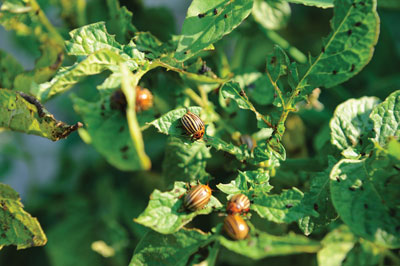
Agriculture and Agri-Food Canada potato research scientists in Fredericton, NB, are confronting a big challenge.
Agriculture and Agri-Food Canada potato research scientists in Fredericton, NB, are confronting a big challenge.

|
| Members of the BioPotato Network in Fredericton, NB, are attempting to transfer genetic resistance to Colorado potato beetle (CPB) from South American wild potatoes to domestic potato species. Advertisement
|
As members of the BioPotato Network, they are attempting to transfer genetic resistance to Colorado potato beetle (CPB) from South American wild potatoes to domestic potato species.
The AAFC Fredericton scientists have been working with the wild Solanum species for insect resistance over the past 15 years. The problem is, explains Dr. Yvan Pelletier, a BioPotato Network research partner, most South American Solanum species are diploid genetically, meaning each of their cells has two sets of chromosomes. Meanwhile, domestic potato varieties are usually tetraploid, with four sets of chromosomes in each cell. According to Dr. Pelletier, this means crossbreeding for insect resistance has to focus on tetraploid wild species or use diploid domestic potatoes.
One way around this could be the use of somatic fusion, but it is a very long process and difficult to achieve, says Dr. Pelletier.
Another challenge the scientists are facing is day length at tuberization. Six of the South American wild varieties under study in Fredericton actually start to tuberize when daylight length is around 12 hours or around of the end of summer in Fredericton. Being from the tropics in the southern hemisphere, this is too late to complete their development in Eastern Canada.
Nevertheless, notes Dr. Pelletier, scientists using seed from an American gene bank started the South American potatoes in a greenhouse before transplanting them to plots at the AAFC Fredericton Potato Research Centre.
Despite significant hurdles, AAFC potato researchers have succeeded in hybridizing three new potato species, two of which they intend to study further to see if they have resistance to CPB. Dr Pelletier says researchers want their internal pesticide study to determine the exact chemical composition of their hybrids’ leaves, after which they will have to determine the active agent against CPB in the leaves’ chemical compounds.
He says scientists are using a new spectrograph to extract the chemicals mixtures, which can also identify 400 different compounds, to speed up their identification of the desired compounds.
Ultimately, BioPotato Network scientists hope to also create a topical bio-pesticide to apply to the foliage of potato varieties not resistant to CPB by using the compounds from CPB-resistant hybrid potatoes, “if they are easy to extract,” says Dr. Pelletier.
He also hopes the chemical compounds are not glycoalkoloids, which are expensive to extract from plant tissue and “impossible to synthesize” as a pest control product.
Moreover, even if glycoalkoloids could be used as a bio-pesticide, they could only be used on crops other than potatoes. If it were to get into the tubers, it would make them toxic to humans, Dr. Pelletier says.
He adds that the federal Pest Management Regulatory Agency will have to approve and register any bio-pesticide developed by the BioPotato Network before it can be marketed.
The network’s current research will conclude in 2011.
Print this page